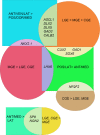An enhanced role and expanded developmental origins for gamma-aminobutyric acidergic interneurons in the human cerebral cortex
- PMID: 24839870
- PMCID: PMC4580098
- DOI: 10.1111/joa.12198
An enhanced role and expanded developmental origins for gamma-aminobutyric acidergic interneurons in the human cerebral cortex
Abstract
Human beings have considerably expanded cognitive abilities compared with all other species and they also have a relatively larger cerebral cortex compared with their body size. But is a bigger brain the only reason for higher cognition or have other features evolved in parallel? Humans have more and different types of GABAergic interneurons, found in different places, than our model species. Studies are beginning to show differences in function. Is this expanded repertoire of functional types matched by an evolution of their developmental origins? Recent studies support the idea that generation of interneurons in the ventral telencephalon may be more complicated in primates, which have evolved a large and complex outer subventricular zone in the ganglionic eminences. In addition, proportionally more interneurons appear to be produced in the caudal ganglionic eminence, the majority of which populate the superficial layers of the cortex. Whether or not the cortical proliferative zones are a source of interneurogenesis, and to what extent and of what significance, is a contentious issue. As there is growing evidence that conditions such as autism, schizophrenia and congenital epilepsy may have developmental origins in the failure of interneuron production and migration, it is important we understand fully the similarities and differences between human development and our animal models.
Keywords: evolution; ganglionic eminences; inhibitory interneurons; telencephalon.
© 2014 Anatomical Society.
Figures



Similar articles
-
Cortical interneurons and their origins.Neuroscientist. 2005 Jun;11(3):199-205. doi: 10.1177/1073858404270968. Neuroscientist. 2005. PMID: 15911869 Review.
-
GABAergic interneuron lineages selectively sort into specific cortical layers during early postnatal development.Cereb Cortex. 2011 Apr;21(4):845-52. doi: 10.1093/cercor/bhq155. Epub 2010 Aug 23. Cereb Cortex. 2011. PMID: 20732898 Free PMC article.
-
Laminar fate of cortical GABAergic interneurons is dependent on both birthdate and phenotype.J Comp Neurol. 2007 Mar 20;501(3):369-80. doi: 10.1002/cne.21250. J Comp Neurol. 2007. PMID: 17245711
-
Origins of cortical interneuron subtypes.J Neurosci. 2004 Mar 17;24(11):2612-22. doi: 10.1523/JNEUROSCI.5667-03.2004. J Neurosci. 2004. PMID: 15028753 Free PMC article.
-
Transcriptional Regulation of Cortical Interneuron Development.In: Noebels JL, Avoli M, Rogawski MA, Vezzani A, Delgado-Escueta AV, editors. Jasper's Basic Mechanisms of the Epilepsies. 5th edition. New York: Oxford University Press; 2024. Chapter 47. In: Noebels JL, Avoli M, Rogawski MA, Vezzani A, Delgado-Escueta AV, editors. Jasper's Basic Mechanisms of the Epilepsies. 5th edition. New York: Oxford University Press; 2024. Chapter 47. PMID: 39637134 Free Books & Documents. Review.
Cited by
-
Epigenetic regulation during human cortical development: Seq-ing answers from the brain to the organoid.Neurochem Int. 2021 Jul;147:105039. doi: 10.1016/j.neuint.2021.105039. Epub 2021 Apr 27. Neurochem Int. 2021. PMID: 33915225 Free PMC article. Review.
-
Cell lineage analysis with somatic mutations reveals late divergence of neuronal cell types and cortical areas in human cerebral cortex.bioRxiv [Preprint]. 2023 Nov 6:2023.11.06.565899. doi: 10.1101/2023.11.06.565899. bioRxiv. 2023. PMID: 37986891 Free PMC article. Preprint.
-
Development and disease in a dish: the epigenetics of neurodevelopmental disorders.Epigenomics. 2018 Feb;10(2):219-231. doi: 10.2217/epi-2017-0113. Epub 2018 Jan 15. Epigenomics. 2018. PMID: 29334242 Free PMC article. Review.
-
The Transcription Factors COUP-TFI and COUP-TFII have Distinct Roles in Arealisation and GABAergic Interneuron Specification in the Early Human Fetal Telencephalon.Cereb Cortex. 2017 Oct 1;27(10):4971-4987. doi: 10.1093/cercor/bhx185. Cereb Cortex. 2017. PMID: 28922831 Free PMC article.
-
MACF1 Controls Migration and Positioning of Cortical GABAergic Interneurons in Mice.Cereb Cortex. 2017 Dec 1;27(12):5525-5538. doi: 10.1093/cercor/bhw319. Cereb Cortex. 2017. PMID: 27756764 Free PMC article.
References
-
- Abematsu M, Kagawa T, Fukuda S, et al. Basic fibroblast growth factor endows dorsal telencephalic neural progenitors with the ability to differentiate into oligodendrocytes but not gamma-aminobutyric acidergic neurons. J Neurosci Res. 2006;83:731–743. - PubMed
-
- Ainsworth M, Lee S, Cunningham MO, et al. Rates and rhythms: a synergistic view of frequency and temporal coding in neuronal networks. Neuron. 2011;75:572–583. - PubMed
-
- Al-Jaberi N, Lindsay S, Sarma S. The early fetal development of human neocortical GABAergic interneurons. Cereb Cortex. 2013 et al. (, epub, ahead of print doi: 10.1093/cercor/bht254. - DOI - PMC - PubMed
Publication types
MeSH terms
Substances
Grants and funding
LinkOut - more resources
Full Text Sources
Other Literature Sources
Research Materials

